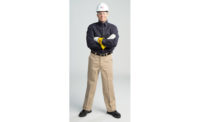Creating a safe work environment is the sum total of many different parts. Elements such as personal protective equipment (PPE) and safety procedures must be viewed through the lens of environmental considerations to ensure workers are safe on a jobsite. With the onset of the winter season, keeping workers both warm and compliant becomes a crucial task for management — especially when accounting for arc flash and flash fire hazards.
A seemingly convoluted issue, layering AR (arc-rated)/FR (flame-resistant) PPE can cause confusion among even those well-versed in the space. Yet, it is possible to layer protective gear while also meeting the requirements outlined by consensus standards such as NFPA 2113 and NFPA 70E. As you layer to achieve warmth, consider these compliance elements when formulating an AR/FR winter weather system.
The foundation
A base layer is a critical component to achieving warmth; however, many popular, non-flame resistant base layers, consisting of manmade fibers such as acetate, nylon, polypropylene and spandex, pose a serious threat to overall arc flash or flash fire protection. These fibers, when exposed to extremely high temperatures of an arc flash or flash fire, will melt and cause serious damage to the wearer’s skin. Both NFPA 70E and NFPA 2113 address base layers. NFPA 2113 require undergarments or base layers to be made of flame resistant or non-melting fabric. NFPA 70E notes that natural — defined as flammable but non-melting — textiles may be used if appropriate arc-rated garments cover the non-FR base layers to prohibit ignition. Considering an AR/FR base layer work shirt meets this mandate, and provides added protection through additional arc-rated fabric layers and associated air gaps between clothing layers.
Utilize performance fabrics
Adding breathable, moisture-wicking fabrics to a system will promote a comfortable wear experience. Given advancements in AR/FR fabric engineering, there are now blended fabrics that provide multi-hazard protection without sacrificing comfort. These innovative blends are helping to remove the constricted feel of stiff work clothing, which promotes worker mobility.
Lead with protection
Regardless of the type of base, or additional layers, you select, protection must be included in the outermost layer. Per NFPA 70E, only arc-rated fabric layers can contribute to the total clothing system arc rating, and NFPA 2113 requires the outermost layer of a system to be flame resistant. In the event of an arc flash or flash fire incident, non-FR outerwear could ignite and continue to burn once a thermal source is removed. Specifying an AR/FR outer garment will not only self-extinguish once a thermal source is removed but will also provide insulation from second- and third-degree body burns.
Assess the system’s arc-rating compliance
Once you have compiled your layered system, you may need to determine the system’s total arc rating. If one of the layers of your system meets the incident energy or PPE Category protection needed, the system does not have to be tested. If, however, you rely on a combination of layers to achieve a higher level of protection, the system will need to be tested to confirm the total system arc rating. You cannot “add” the layers together — a Category 2 shirt and a Category 2 jacket does not translate to Category 4 protection, or an 8 cal/cm2 shirt and 12 cal/cm2 jacket does not necessarily translate to a 20 cal/cm2 total system arc rating. A system’s arc thermal performance value (ATPV) or an Energy Breakopen Threshold (EBT) is established by testing the complete system according to the ASTM F-1959 test method. If your layered combination has not been tested for a system arc rating, then the highest individual garment arc rating of the system is what should be used as the system arc rating per NFPA 70E.
It is possible to meet the environmental demands of the winter months while also adhering to the standards governing your industry. Eliminating the need to prioritize compliance over comfort, managers and safety engineers are able to outfit their workers, even in winter, with protection in mind.






